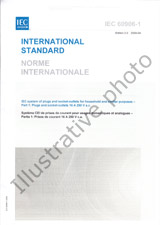We need your consent to use the individual data so that you can see information about your interests, among other things. Click "OK" to give your consent.

IEC 62153-4-6-ed.2.0-RLV
Metallic cables and other passive components test methods - Part 4-6: Electromagnetic compatibility (EMC) - Surface transfer impedance - Line injection method
Translate name
STANDARD published on 25.8.2017
The information about the standard:
Designation standards: IEC 62153-4-6-ed.2.0-RLV
Publication date standards: 25.8.2017
SKU: NS-1095981
The number of pages: 45
Approximate weight : 135 g (0.30 lbs)
Country: International technical standard
Category: Technical standards IEC
The category - similar standards:
Annotation of standard text IEC 62153-4-6-ed.2.0-RLV :
IEC 62153-4-6:2017 RLV contains both the official IEC International Standard and its Redline version. The Redline version is available in English only and provides you with a quick and easy way to compare all the changes between the official IEC Standard and its previous edition. IEC 62153-4-6:2017 determines the screening effectiveness of a shielded metallic communication cable by applying a well-defined current and voltage to the screen of the cable and measuring the induced voltage in order to determine the surface transfer impedance. Measurements in the frequency range from a few kHz up to and above 1 GHz can be made with the use of normal high frequency instrumentation.
We recommend:
Technical standards updating
Do you want to make sure you use only the valid technical standards?
We can offer you a solution which will provide you a monthly overview concerning the updating of standards which you use.
Would you like to know more? Look at this page.



 Cookies
Cookies
